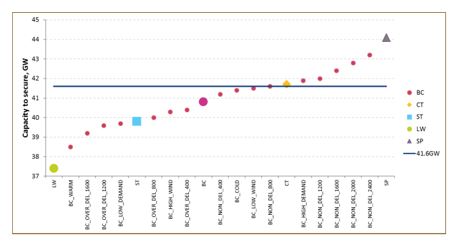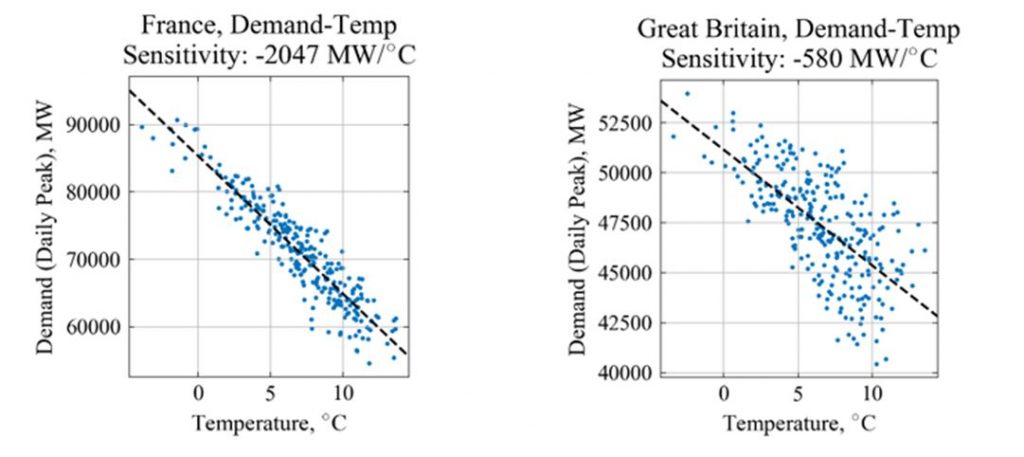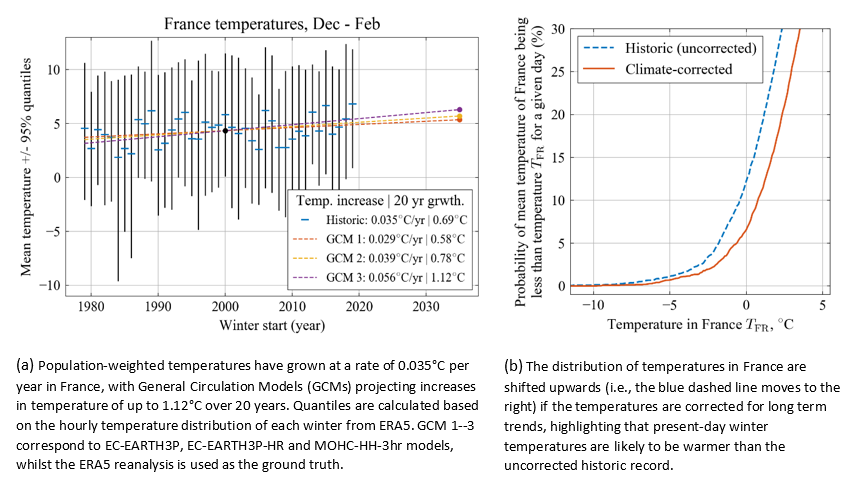Feedback to BEIS Panel of Technical Experts on interconnector modelling in the
2021 Electricity Capacity Report
Dr Matthew Deakin, Dr Hannah Bloomfield
Background
National Grid Electricity System Operator (NGESO) recently requested feedback from the community on their Summary Briefing Note, “Modelling de-rating factors for interconnected countries in the 2021 Electricity Capacity Report”. The severe Texas blackouts this winter have brought the issue of resource adequacy sharply into focus, with technical developments in European capacity markets via the European Resource Adequacy Assessment (ERAA) ongoing to ensure market-based solutions can provide energy system resilience as countries transition to net-zero.
Supergen Energy Networks (SEN) responded to NGESO’s call for feedback last year. We discussed how bidirectional flows from interconnectors mean that the marginal value of increased interconnection for individual countries can be both positive and negative with respect to resilience (particularly when the stress periods of multiple countries coincide), in contrast to conventional generation assets which always improve resilience. This year, NGESO have specifically requested feedback on the scenarios they are developing for interconnected countries, used to inform sensitivity analysis which identify a range of de-rating factors for new and existing interconnectors. Ultimately, de-rating factors are then used by the Secretary of State to determine the capacity volumes that interconnectors can bid into the capacity market.
How are Scenarios used in the GB Capacity Market?
Capacity markets are designed to provide a price signal to incentivise investment in generation to provide resilience, explicitly taking into account uncertainties in supply and demand. On the supply side, these uncertainties include the closing date of generators close to the end of their life, the commissioning dates of new assets, or even the availability of network infrastructure such as subsea cables. On the demand side, the uptake of new technologies mean that both peak and average GB demand changes from year to year, whilst nascent Demand Side Response technologies can also address tight margins, as they have done in GB for many years under the guise of ‘Triad avoidance’. Additionally, as we discuss in this note, both supply and demand are sensitive to climate variability and climate change, due to the weather sensitivity of renewables and demand.
The GB Capacity Market uses the “Least Worst Regret” approach to determine the required Capacity to Secure under these uncertainties (the Capacity to Secure subsequently determines how much generating capacity is procured for future winters). This approach evaluates the capacity that would be required to meet demand under a wide range of credible scenarios. The overall target Capacity to Secure is then calculated that will minimise the cost of generation overspend (based on the costs of building new generation) against the societal costs of controlled demand disconnection (based on the value of lost load) so that the target demand for the capacity market will minimise the potential ‘regret’ of overspend.
How could Climate Change Variability affect these Scenarios?
The scenarios that are selected for modelling are overlaid on top of a central scenario, representing a best guess of the state of the future system in between one- and five-years’ time, using nominal uncertainties on both the supply and demand side (Figure 1). One source of uncertainty here is the weather. To account for this, 30-40 years of historical weather data would typically be used to model a wide range of possible outputs from weather-dependent renewables in this central scenario, rather than selecting a year with particularly poor weather (which is typically included instead as an individual scenario). Similarly, as demand is strongly dependent on temperature (Figure 2) due to electric heating loads, the distribution of daily peak demand can also be ‘hindcast’ using 30-40 years of historic temperature.

There are therefore two ways that climate variability and climate change can impact on the scenarios used in the capacity market. Firstly, as the 30-40 year period used in historical assessment is relatively short, it may therefore be that as-yet unseen weather conditions, simulated in climate models, may need to be considered to adequately study possible risks of shortfalls. Additionally, long-term climate variability can also lead to the likelihood of adverse conditions being much greater in a given decade. Plausible scenarios modelling challenging weather years may need to be synthesised to model periods with higher demands and lower wind generation than exists in the historic record.

Additionally, it could be that the modelling of the Central scenario, based on the long-term climate, will also be impacted by climate change. This could affect the Capacity to Secure calculations of all scenarios (except those scenarios focusing on specific weather conditions). For example, there is a clear warming trend in historic temperature data over France since 1980 (Figure 3a), such that if the temperature is corrected to account for this, the modelled northwest European temperature would rise close to 1°C. Although the change in mean temperature is relatively small, the shift in the temperature distribution (Figure 3b) means that the likelihood of cold temperatures can be affected significantly. For example, the likelihood of the mean daily temperature of France being below freezing reduces from 12.2% to 6.5%.
Physically, this de-trending of temperatures is meaningful as circulation in the atmosphere (driving weather fronts and wind) is thought to only be weakly dependent on the background temperature. Milder temperatures lead to reduced peak demands and therefore reduced requirements for expensive peaking capacity.

What was the feedback we provided to BEIS Panel of Technical Experts?
Given the sensitivity of peak demand to temperature shown in Figure 2, a 1°C increase in winter temperatures would lead to a reduction in the required capacity of around 500 MW in GB, or more than 2000 MW in France. The costs of providing this capacity are not inconsequential – for example, at a cost of new entry of £49/kW used in the GB capacity market, a 500 MW overestimation in the capacity required leads to an increase in costs of £24.5m per year. It is worth noting however, that this could also lead to a slight reduction in the likelihood of shortfalls.
In our feedback we took the view that the scenarios that NGESO have discussed around the modelling of interconnectors (including concerns around early closure of Coal and Nuclear plants in mainland Europe) are well justified. However, we also suggest that accounting for long-term climate change can and will have an impact on calculations of target Capacity to Secure. The de-trending of temperature is a relatively minor technical fix that could avoid costly over-procurement in the long run. Incorporating as-yet unseen, severe winter events is also a possibility by making use of longer-periods of historical data (including appropriate detrending) or output from climate model simulations. Ongoing work as part of the CLEARHEADS project will be further exploring these areas, and will be providing open-access suitable de-trended data. This will give energy modelers easy access to the data required to study the impacts of climate change on a wide variety of problems beyond the capacity adequacy issues discussed here.
Conclusions and future challenges
Systemic changes in climatic conditions will change the risk profile of energy systems heading toward net-zero, particularly in view of rapid increases in renewable capacity and electrification of heating demands in winter-peaking systems. Understanding both the severity and coincidence of system stress is necessary for an accurate determination of the value of interconnection for providing resilience.
The provision of secure, cost-effective and low-carbon energy will result in energy systems becoming increasingly weather dependent. We conclude that energy modelers will therefore need to become highly skilled in the handling and analysis of significant quantities of climate and weather data, used across a wide range of scales and contexts, to effectively address whole energy system design challenges on the path to net zero.
Feedback to BEIS Panel of Technical Experts
The feedback is available to view and was written with contributions from Dr David Greenwood, Dr Susan Scholes, Dr David Brayshaw and Professor Furong Li. The authors are also grateful for feedback from industrial advisor to the project, Dr Chris Harris. Matt and Hannah are support by the Supergen Energy Networks CLEARHEADS Flex Fund project, led by the University of Reading. Contact: matthew.deakin@newcastle.ac.uk; h.c.bloomfield@reading.ac.uk
About the authors

Dr Matthew Deakin is a postdoctoral Research Associate at Newcastle University with the Power Systems group. His research interests include whole energy systems analysis, power system planning and operations, and smart grids.

Dr Hannah Bloomfield is a post doctoral Research currently working in the University of Reading meteorology department. Her research focuses on understanding natural and societal challenges to present and near-future energy systems. Her past work focused on the impacts of climate variability and climate change on international power systems including large proportions of renewables.